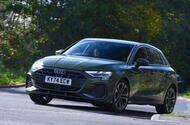In a world of SUVs and electrification, did a diesel hatch still do it for us?
Depending on which day you ask, hatchbacks are my favourite kind of cars. And most days, I stand by that statement.
I suspect it’s my generation – millennials, we’re called – growing up in the hatchback’s heyday. Maybe someone 20 years younger would say the same about SUVs…
For me, a hatchback is perfectly practical and the best size for all scenarios: suburban living, tight car park spaces, motorway driving and, most notably, handling on country roads. Driving a Volkswagen Golf R in north Wales years ago still stands out as one of those days of purest pleasures.
So when it was revealed that I would be the caretaker of a new Audi A3 Sportback, I was pleased. I drive a variety of cars, but hatchbacks don’t come round too often these days, for all the reasons we’re familiar with.

I often wonder how much cannibalisation goes on between a brand’s hatchback and similarly sized SUV, because there absolutely must be some. Indeed, I worry that the popularity of SUVs will kill off hatchbacks. But happily the A3 is still going strong.
It accounts for a notable 25% of Audi’s UK sales, and in terms of the crossover between it and the Audi Q3, the firm tells me: “One year, [someone] may buy an A3 and when they come to renew they may have new requirements (for example, a family or a dog) whereby a Q3 may be more suitable for their needs – or they may be in a Q3 and want to downsize to an A3.”
What’s more unusual than having a hatchback in an era of SUVs is that it’s… a diesel. Remember those? Remember when they took 50% of new car sales?
Diesel now accounts for less than 5% of A3 Sportback sales, but Audi still thinks it’s worth having it in the mix. While diesel was once the first choice for company car buyers, they now favour plug-in hybrids and EVs. Instead, it’s high-mileage retail customers who are opting for this powertrain.
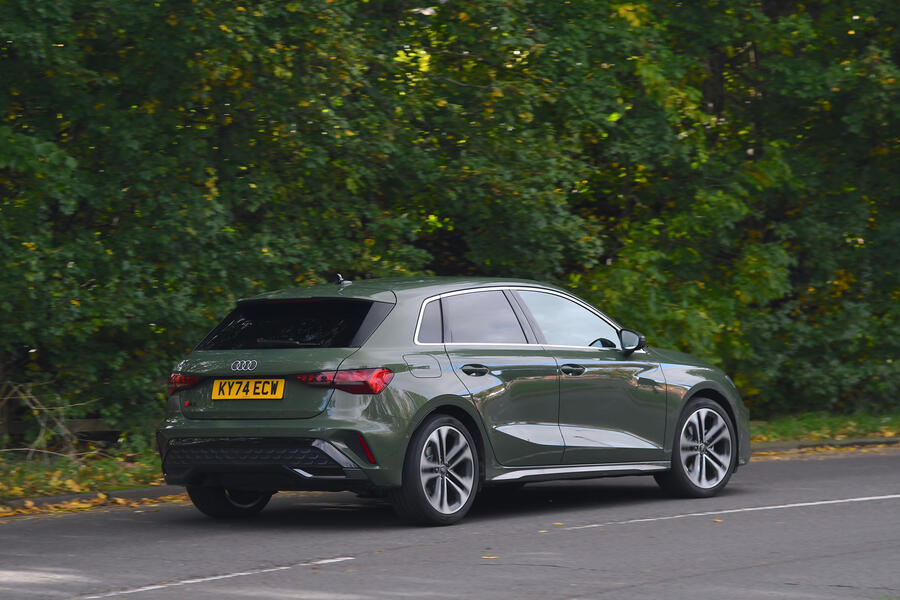
The engine is a 2.0-litre turbo four delivering 148bhp and 266lb ft at 1600-2750rpm, mated to a seven-speed automatic gearbox. It takes 8.1sec to hit 62mph and the top speed is 141mph. I haven’t written about a diesel for a while, but that all sounds as I’d expect it to.
Our car is in S Line trim, which sits between the basic Sport and the range-topping Black Edition. The A3’s starting price is £29,515 (less than £30k!), rising to £31,845 for the S Line. That’s for a 1.5-litre
turbo petrol four with a six-speed manual. For this diesel, the price creeps to £38,355.
There’s inevitably a long spec list, including 18in alloy wheels, a 10.1in touchscreen, heated leather sports seats and plenty of sporty design touches, including a gloss dark chrome finish for the front grille, sportier-looking bumpers, a spoiler and a rear diffuser in matt black.
Most notable technically is the addition of sport suspension, which has “more dynamic spring/ damper adjustment” and lowers the ride height by 15mm for “more direct contact with the road and sportier handling”, claims Audi.
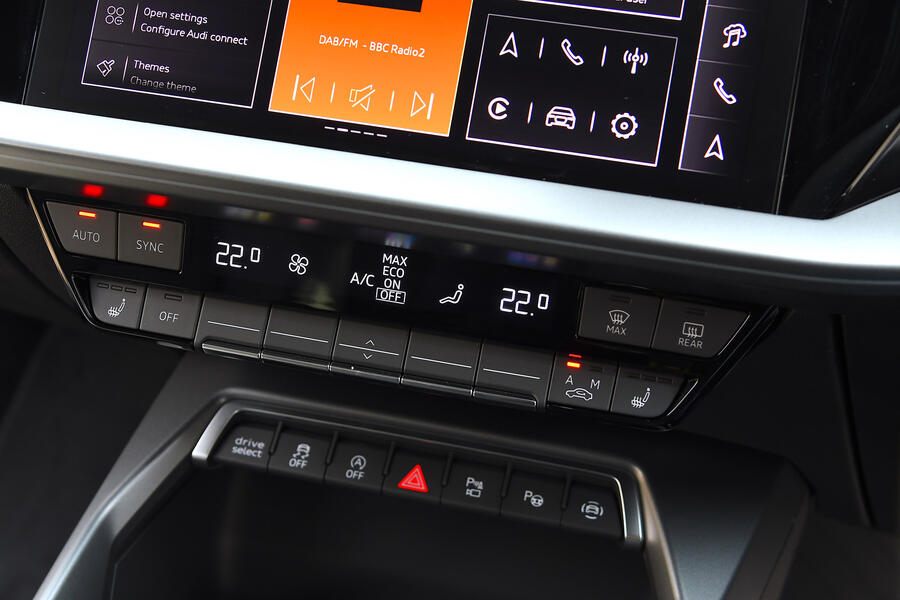
Just two options are fitted to our car: the already much-discussed Distinct Green metallic paint (£595) and the Technology Pack (£1495), which includes a head-up display, a reversing camera, adaptive cruise control (without speed limiter) and a Sonos 3D premium sound system.
There’s one considerably more expensive pack, the similarly named Technology Pack Pro, which for £4390 adds matrix LED headlights, multiple driver assistance systems, a panoramic sunroof, a ‘comfort key’ (that’s keyless entry to you and me) and electrically adjustable front seats with memory function. That’s it on the packs, which is pleasingly simple for buyers.
When the A3 first arrived, it didn’t even have three digits on the clock, so it’s still too early in the run-in phase to judge fuel economy against the official figure of 55.4mpg.
First, I observed the car’s good looks: I typically like hatchback proportions and this S Line spec, complete with spoiler and other touches, makes it appear sleek and smart without trying too hard.
Second, I was surprised by how much I noticed the lack of instant torque, having run cars with electric motors for so long. Our just-gone Lexus LBX was only a hybrid, but it still permitted an effortlessly smooth departure.
I suspect very few buyers are going from hybrids to diesels (but I would be interested to hear from you if you have) and, inevitably, I quickly adapted to moving away fluidly in this diesel A3, but on that first go it was a little off-putting.
No complaints about the A3 during my short stint so far. Well, actually, once I’ve finished writing this I’m off for my second attempt to connect to the MyAudi phone app, having lost my patience the first time round. But nonetheless, so far, so enjoyable.
Update 2
Having spent a couple of months in this diesel A3, I’ve had plenty of time to ponder the evolution of diesel power.
Not least because its almost inevitable fate is a result of a scandal that involved former derivatives of this very engine used across the Volkswagen Group, of which Audi is part.
The drama of Dieselgate is hard to grasp 10 years on – how shocking it was and how it affected an entire industry when diesel really was in its heyday.
Not to say that the world wouldn’t have evolved by now regardless (bad news stories about pollution from fossil fuel-burning cars didn’t just become a thing because of the scandal), but it certainly exacerbated the issue.
And yet here I am with a diesel A3, which accounts for 5% of A3 sales (the overall UK diesel market share last year was 6.3%). Audi hasn’t said it will stop selling it, but with those gures it seems hard to justify.
Plus, when I asked about the future of diesel for Audi, a brand spokesman said: “Audi has just launched a new generation of diesel engines for the A5 and Q5 families, featuring a completely new mild hybrid-plus system that further reduces CO2 output and increases performance.
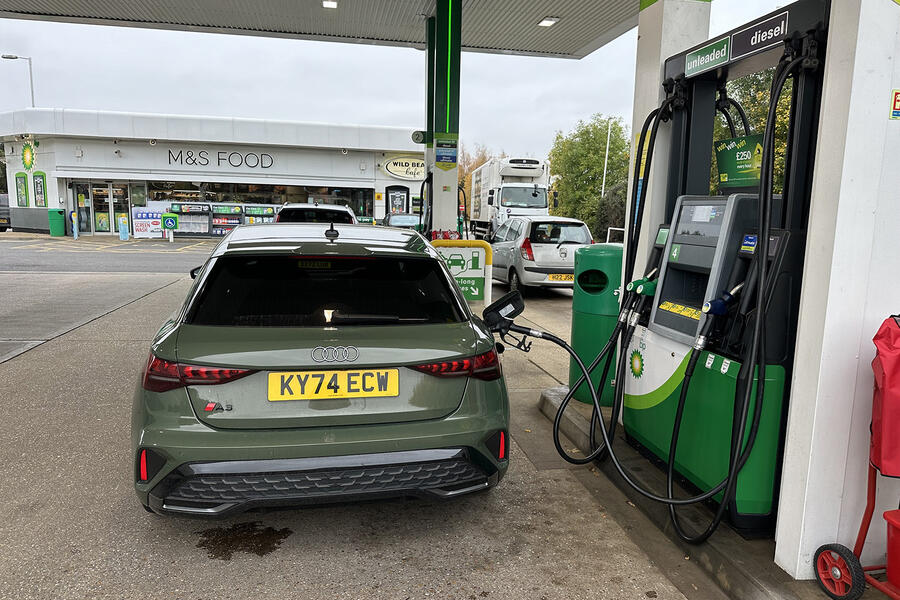
But Audi has a clear roadmap for the transition to electromobility: “2026 marks the turning point in our strategy.” That turning point means no non-electric Audis will be launched from next year – but that’s not to say the firm won’t leave ageing ICE cars on sale for a longer period, especially in markets where EVs aren’t yet viable.
Without that background context, and assessing a car purely on its own merits, what would I, or newcomers to diesel, make of this smart, gas-guzzling Audi?
As I mentioned in my first report, it took a few journeys to adapt to not having instant power from the 1968cc turbo four at start-up in the way of many hybrids I’ve run lately.
But the diesel A3 is effortless to drive and it remains satisfying to see the range slowly drop from the 500s, meaning I rarely need to go to a garage. Convenience is king and all that. I’m getting 51.4mpg, which is not far off the official 55.4mpg.
Not many people I know drive a diesel these days, but just the other week I went to see an old friend and her family in Hertfordshire and there on the drive were not one but two diesels – a Mini Countryman and a Skoda Kodiaq.
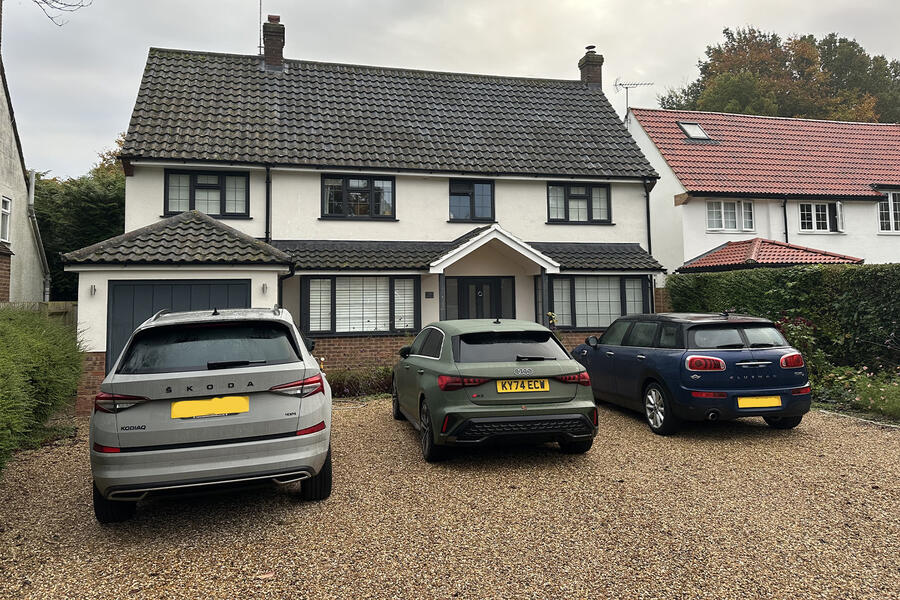
I asked why they had gone for diesels and was told: “They emit less CO2 and need filling up less often. Not living in an urban area makes the air pollution impact less of a concern and the higher torque is good for heavier cars.
“EVs are really expensive: you would have to rack up a higher mileage than a diesel to recover the initial cost and the environmental impact of building the car. Plus there’s range anxiety.”
Diesel may have only a handful of remaining fans based on its market share, but those hanging on – who understand the pros and cons and recognise it suits their lifestyle – still think there’s a place for it. Like them, I’ll be making the most of my diesel while I still can.
Update 3
When we welcomed this car to the Autocar fleet, road test editor Matt Saunders wrote: “I’ll be keen to find out if Rachel thinks an A3 S Line diesel still feels sufficiently ‘2024’ or like a car ready for retirement.”
When I first stepped into the A3, having come from a Lexus LBX, an all-new hybrid, the experience did feel very analogue. Not in a negative way but a notable way nonetheless. Inside, there’s a modestly sized touchscreen running familiar Volkswagen Group so ware, plus lots of buttons, and they’re all properly tactile – none of this haptic hoo-ha.
The seats are adjusted using a simple handle, which I’ve always thought just as effective as the electronic alternative anyway. And then there’s the inability to open the doors without using the key fob.
That’s the worst of it for me: when carrying various bags and possibly a tantrum-throwing four-year-old, I don’t want to have to press the button on a key that is attached to my hand but hidden among all the other stuff.
To have that functionality on the A3, you need to pay for the super-shiny Advanced Tech Pack at a cost of £4390… As I discussed in my 5 February report, diesel powertrains do feel somewhat anachronistic now.
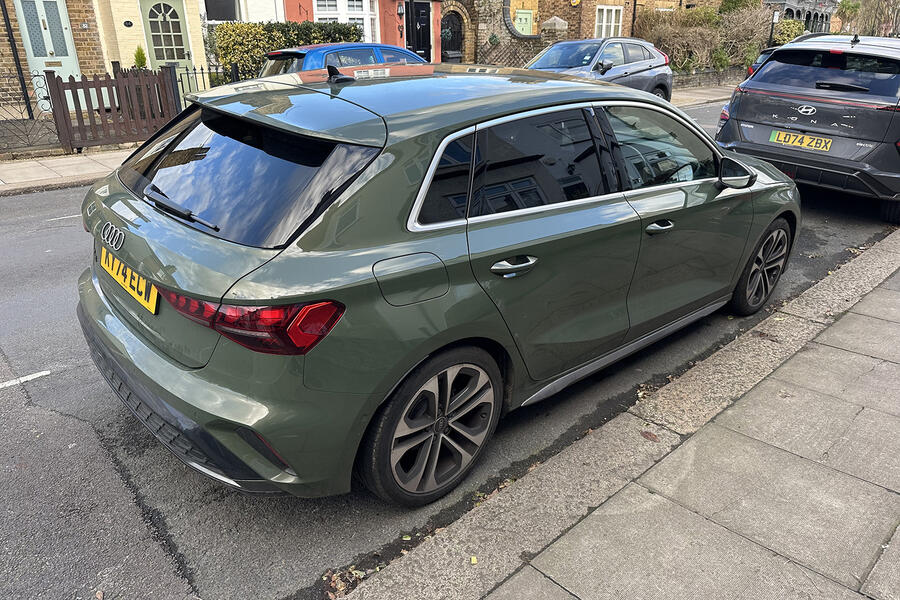
Still, having adapted to the lag in torque not found in electrified cars, it has quickly become familiar, and this 2.0-litre four-cylinder engine with 148bhp is perfectly decent.
When I took a very slow journey from west to east London on a Saturday afternoon, it was noisy, but diesels aren’t made for that sort of job, and it didn’t feel unforgiving.
As with everything, time (mostly) normalises experiences: a er a few months in the A3, I can hardly remember feeling that it was analogue in the first place (thank heavens for my notebook). But this car is getting old now: it was launched in 2020 and facelifted in 2024.
As with practically every car maker out there, Audi has focused its efforts on accelerating its EV development and just left its combustion-engined cars ticking over with a nip and tuck occasionally.
That seems savvy from a business perspective: there’s only so much money to go round and you can still appeal to those who don’t want EVs or hardly have the option in some markets.
Despite some of its ageing traits, there’s plenty to commend the A3. The District Green paint (which I incorrectly called Distinct Green before; thanks to reader Richard for pointing it out) feels modern and the white and black badge detailing of S Line trim looks similarly on-trend and far better than chrome.
All the legally required ADAS functions can be jarring but less so than in some rivals. I have the ability to charge my phone, use Apple CarPlay for sat-nav and more, listen to the radio, heat my bum on a cold day and get from A to B in a comfortable, usable space.
What more could I need? There’s no doubt that this A3 feels long in the tooth in a world of brand new EVs and space-age interiors. Comparison is everything. But during my time with it so far, this car feels as up to date as any needs to be – depending on your powertrain preference, of course.
Final update
Go back a decade or two and an Audi A3 was the slightly posher mainstream choice for an everyday car.
If you wanted to be a bit more fancy than a Ford Focus or even a Volkswagen Golf, this (or a BMW 1 Series) was it. Audi even claims to have established the premium compact segment by introducing the A3 in 1996.
Times have changed in the car buying world, but this hatchback is still more important for Audi than some people might expect. It accounts for a quarter of the firm’s sales and is its best-selling model.
From the moment I stepped into the A3 at the end of last year, I could see why, and since then, it has been one easy, effortless journey a er another. What did I like particularly? Well, it’s a handsome if safe-looking car but I don’t think there’s a spec or colour that suits it better than this one.
The S Line detailing is sporty without being too try-hard and the white-on-black Audi logo and lack of chrome are tting. Inside, the user experience is a trusty, familiar one, even with fewer touchpoints than previously.
The set-up is self-explanatory so you don’t find yourself looking for basic functions and the layout and fonts on the touchscreen are intuitive and, to my eyes, agreeable.
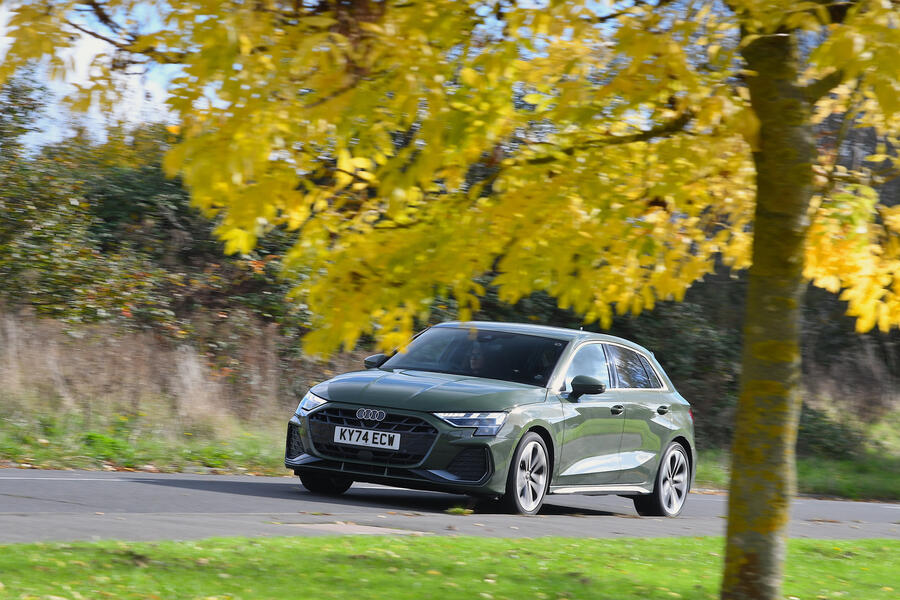
Maybe it’s partly through the familiarity of Volkswagen Group products, but nonetheless it’s coherent. And as Felix Page mentions (right), the tactile buttons are very welcome.
Apple CarPlay, which I’m rarely without, integrated easily each time and attaching my phone to charge via wire provided a fast charge for its fast-failing battery… Sitting in the cabin, the accessibility of everything feels in reach and well proportioned, so there’s enough space for your typical needs (unless there are four 6-plus occupants).
I always found the seats to be comfortable and provide decent lumbar support and, given my lower back is increasingly twingey as I age, the A3 was one of the kinder cars I’ve driven of late for a lengthy journey. I also enjoyed driving it.
The first couple of journeys required some readjustment to the relative shortage of initial torque from a diesel compared with the electrically assisted motors I’d been driving, but I soon didn’t give it a second thought.
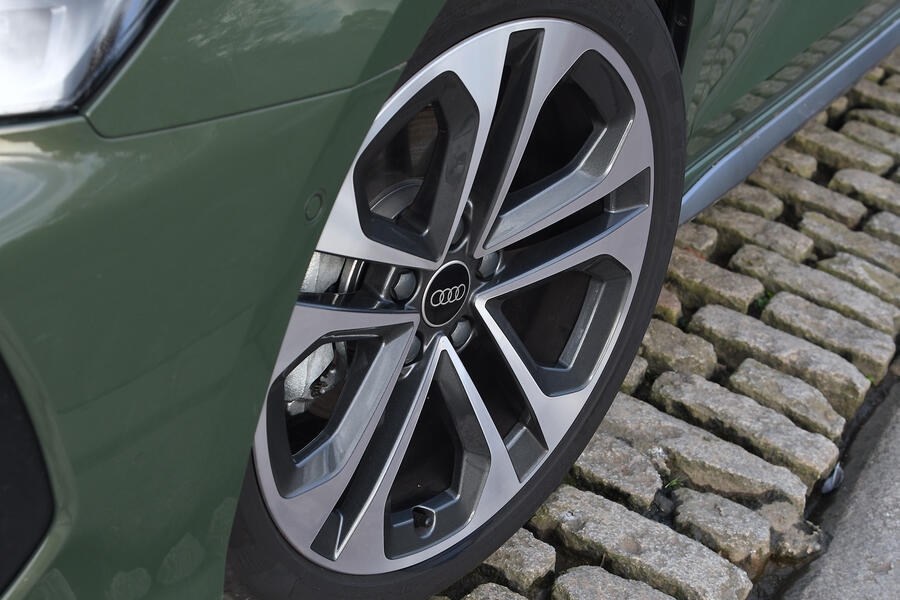
This isn’t a speedy car per se but 8.1sec for 0-62mph from its 148bhp 2.0-litre diesel is more than enough pace even on motorways. The other obvious benefits of a diesel powertrain are the fuel economy and how rarely you have to fill up.
When the range drops so slowly from above 500 miles, you feel spoiled by the convenience factor of not having to schedule fuel stops at annoying moments when you don’t really have time.
And then there’s the fuel economy, which is decent, if not exceptional. During our time with the A3, it returned 50.8mpg but sometimes achieved very close to the claimed combined economy of 55.4mpg.
Being behind the wheel is undemanding. I know there are rivals with better steering feel but there’s enough direction to make suburban manoeuvring trouble-free while also facilitating a little verve on rural, bendy roads, helped by the dimensions of a hatchback, which makes it a lovely thing to place on any road.

Even in a world of SUVs, this hatchback feels big enough to hold its own without being preposterously oversized. Then there’s the way you’re treated by other road users. It’s fascinating as an automotive journalist to observe how peer drivers respond depending on which car you’re in.
It’s subjective, of course, but I don’t think Audis are the most-liked cars, or at least there was an era of that in the past 20 years or so, but this specific model appeared to be regarded by other drivers as inoffensive, which is welcome for someone who doesn’t like to stand out.
Was there anything that grated? Happily, not much. The 380-litre boot space – pretty standard for a hatchback – seemed a bit lacking, perhaps because I’ve become used to the greater height of more SUV-like cars. In my current life, fitting my little boy’s bike in easily is my measure of ease for a boot and this took some choreographing.
Other things: the diesel engine felt like it could have been more refined but I imagine that’s the inevitable outcome of diesels no longer being honed as EV development is prioritised; I found the typically German executive black interior somewhat dull and claustrophobic; but the most annoying thing of all – in terms of what affected my ease of living most notably – was the absence of keyless entry, which is available only as part of a costly pack.
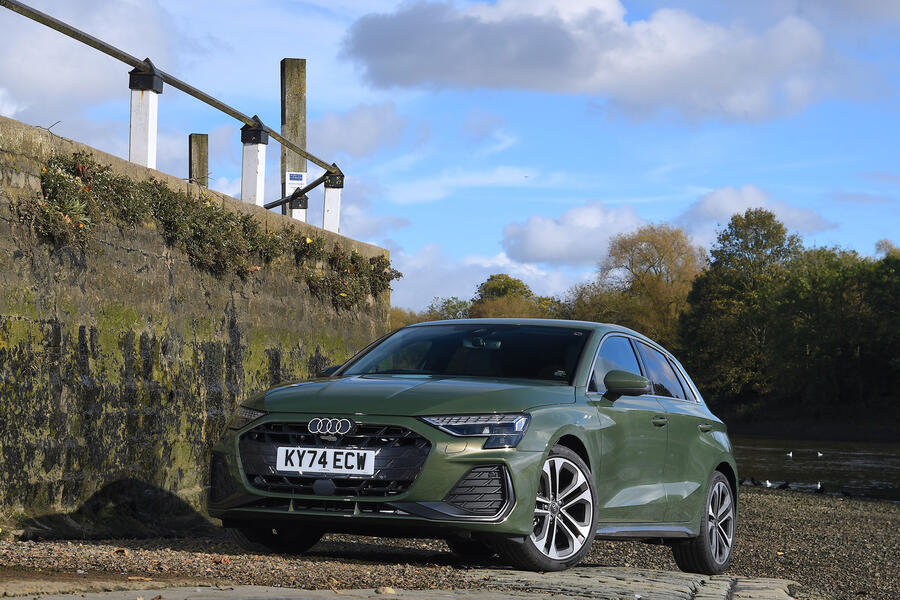
Perhaps I’m being demanding, but in this day and age, keyless entry feels a given. Grumbles aside, this is a car that makes me feel as warm towards the premium hatchback segment as I always used to be.
It’s traditional in a comforting way without feeling out of date or irrelevant and has all the mod cons you want (and don’t).
Diesel’s death seems inevitable – though stranger things have happened – and such outcomes become self-fulfilling when upgrades aren’t made.
Its appeal remains for those who do many long journeys but, as the stats show, the natural choice – which would be mine – is the higher-powered petrol TFSI or the PHEV. Next year, the A3 across all its generations will be 30 years old. I’m hopeful it has many more to come.
Audi A3 Sportback 35 TDI S Line S Tronic specification
Prices: List price new £36,265 List price now £37,160 Price as tested £38,355
Options: Technology Pack £1495, District Green metallic paint £595
Fuel consumption and range: Claimed economy 55.4mpg Fuel tank 50 litres Test average 50.8mpg Test best 54.8mpg Test worst 47.3mpg Real-world range 559 miles
Tech highlights: 0-62mph 8.1sec Top speed 141mph Engine 4 cyls, 1968cc, turbo, diesel Max power 148bhp at 3000-4200pm Max torque 266lb ft at 1600-2750rpm Transmission 7-spd dual-clutch automatic Boot capacity 380 litres Wheels 8.0Jx18in, alloy Tyres 225/40 R18 Kerb weight 1485kg
Service and running costs: Contract hire rate £420.88 CO2 134g/km Service costs None Other costs None Fuel costs £280.74 Running costs inc fuel £280.74 Cost per mile 13 pence Faults None
Source: Autocar
